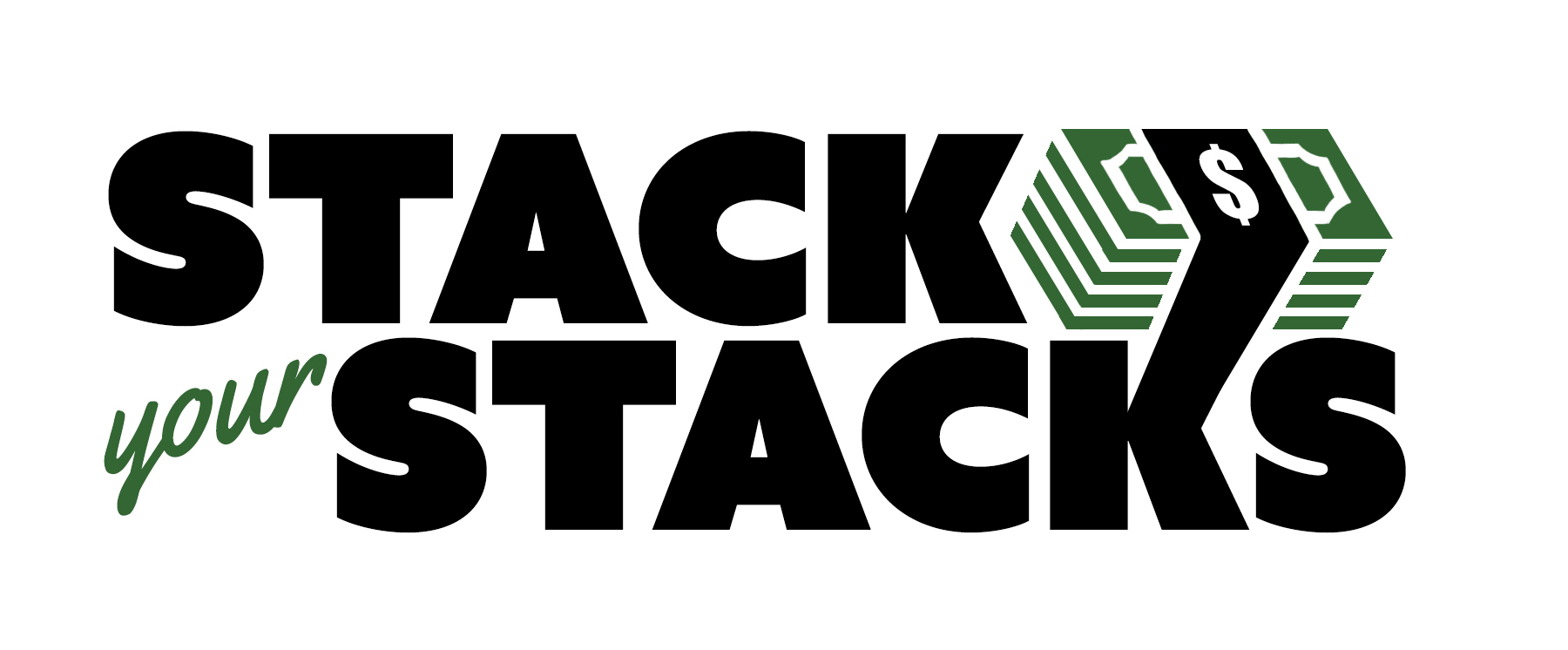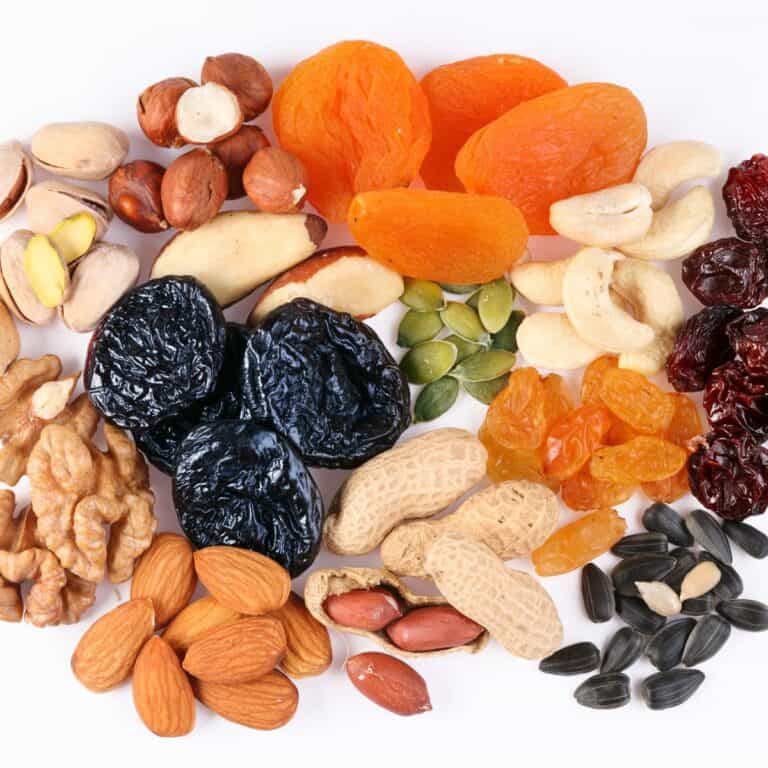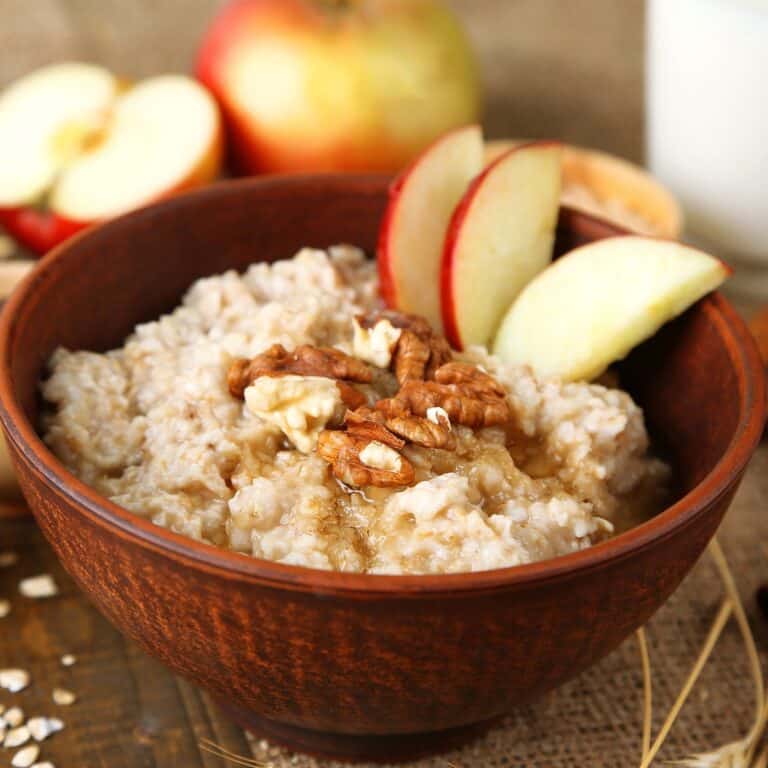Flashfood Review: How I Save Money on Groceries!
Looking for ways to save money on groceries? You’ll love the Flashfood app! You can use the app to score discounted groceries, helping to combat those rising food costs we’re all dealing with right now. Learn more about how it works and what to expect in this Flashfood review, based on my personal experiences using the app over the last year.
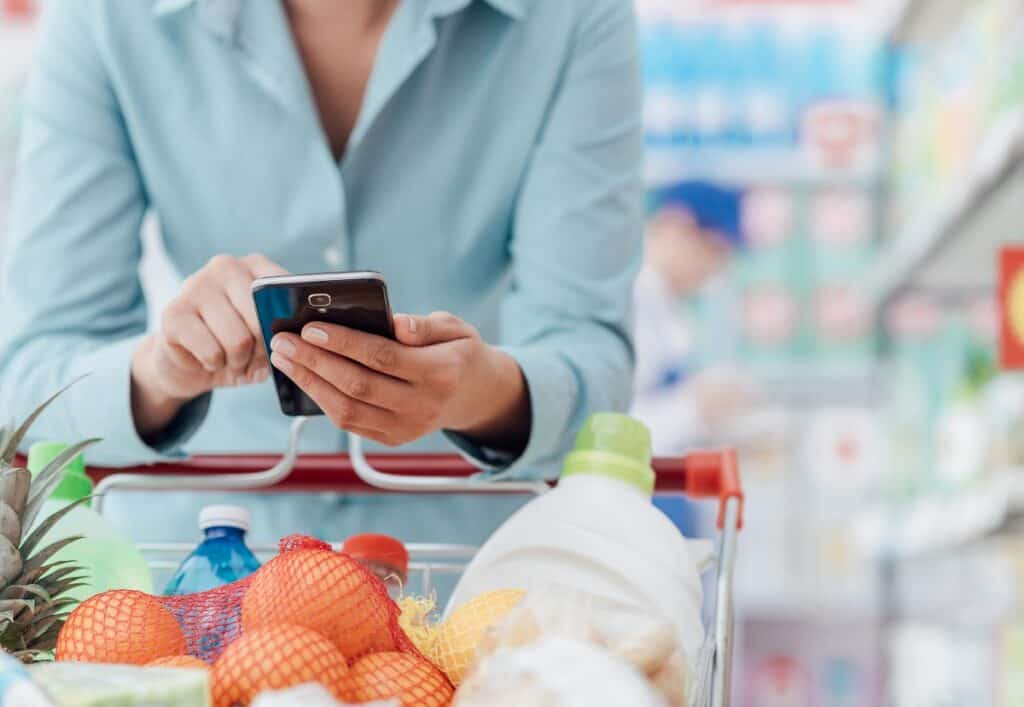
What is Flashfood?
Flashfood is a free mobile app that provides local grocery stores with a way to offer discounted food items. They feature locations in the United States and Canada. Since grocery stores choose to partner with the app, the specific stores will vary based on location. For example, near me, there are only Stop and Shop locations available right now.
You can download Flashfood from both the App Store for Apple as well as Google Play Store for Andriod.
BONUS: Use my referral code CHRI2VVQP when you sign up! When you make a first purchase over $10, we’ll both get $5 in rewards!
Once you download the app, you’ll be able to see if there are any stores in your area. If you find a store, you can click to view all the available foods. There are often lots of great cheap food options! (Keep in mind I live in a relatively high cost of living area, so pricing may be different near you).
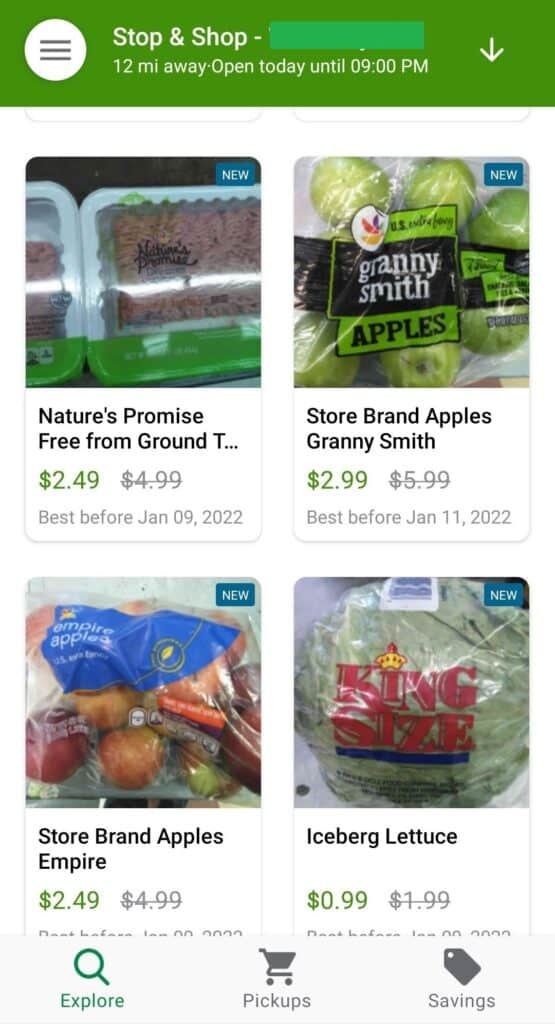
You purchase foods right on the app. After you order, you’ll see a section in the app with pickups – if you click that, you can view exactly what you ordered. Here’s an example of a recent order and what that looks like:
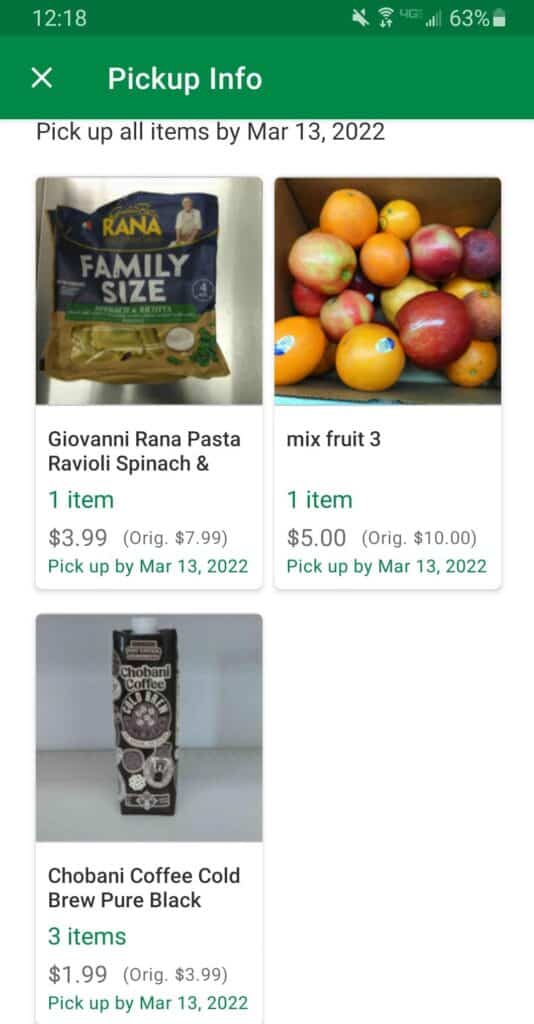
Then you just head into the store to pick them up. There is typically a large Flashfood cooler by the checkout area of the store. Depending on the store, an employee at self-checkout will help find your ordered items from that cooler (how it works for our stores), or an employee at customer service will confirm your order and you will go find it from the cooler (how it works in some other stores).
Easy peasy!
What kinds of foods are on Flashfood?
The grocery items on Flashfood vary widely depend on what the store has excess of or what they’re looking to get rid of quickly. Note that not all items are close to expiration; some are simply overstock.
Here’s a few common things you’ll find:
- Produce boxes – Many Flashfood locations offer $5 produce boxes. These can be vegetables only, fruit only, or a combination. In my opinion, these are one of the absolute best deals that you can score. Sometimes the produce is items with slight imperfections, and other times it’s items they just have extra of in stock.
- Individual produce – In addition to the boxes, I frequently see individual produce items like bags of salad, cauliflower, apples, etc.
- Meat and fish – You’ll often see meat and fish that is a day or two away from it’s sell by date. These are great for purchasing for a last minute dinner if you know you’ll cook them that day.
- Prepared foods – We often see prepared foods like buffalo chicken, mac and cheese, ravioli, etc.
- Dairy products – In our area, certain dairy products are not frequently on the app, but we do see yogurt quite a bit. They are often flavors that have been discontinued or yogurt that’s reaching it’s best by date.
- Baked goods – Baguettes, french bread, and pizza crusts are often on the app in our area! As are day-old sweet treats from the store’s bakery, like cookies or cupcakes.
- Extras – Often, the store will list random items that they have overstock of – for example, we’ve gotten coffee butter, key lime cookies, and cold brew coffee this way!
Sample Orders
Here are just a few sample orders that I’ve gotten over the last year.
Below, you’ll see a banana box, a mixed vegetable box, a mixed fruit box, burgers, sausage, and ravioli. Total price? $22.
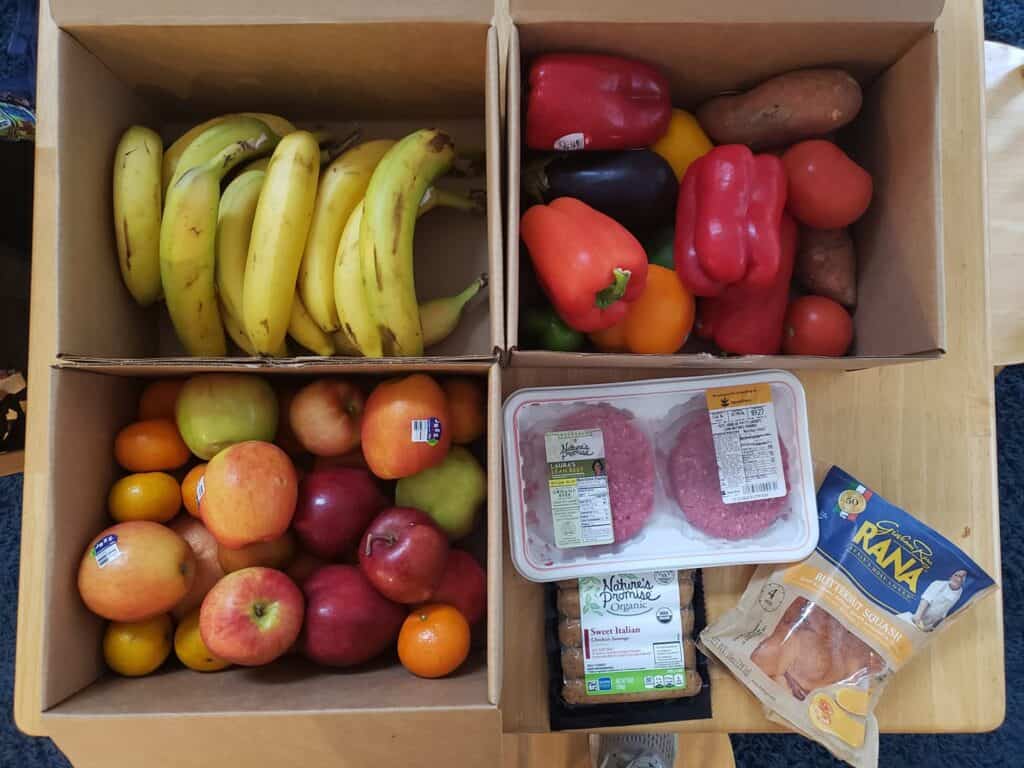
Here’s another order with a mixed vegetable produce box, a mixed fruit box, and a banana box, totaling $12. (My store sells the banana boxes for only $2, which is amazing! We eat some, use some for banana bread, make banana oat pancakes (one of my fav frugal breakfasts) and then freeze the rest for smoothies.
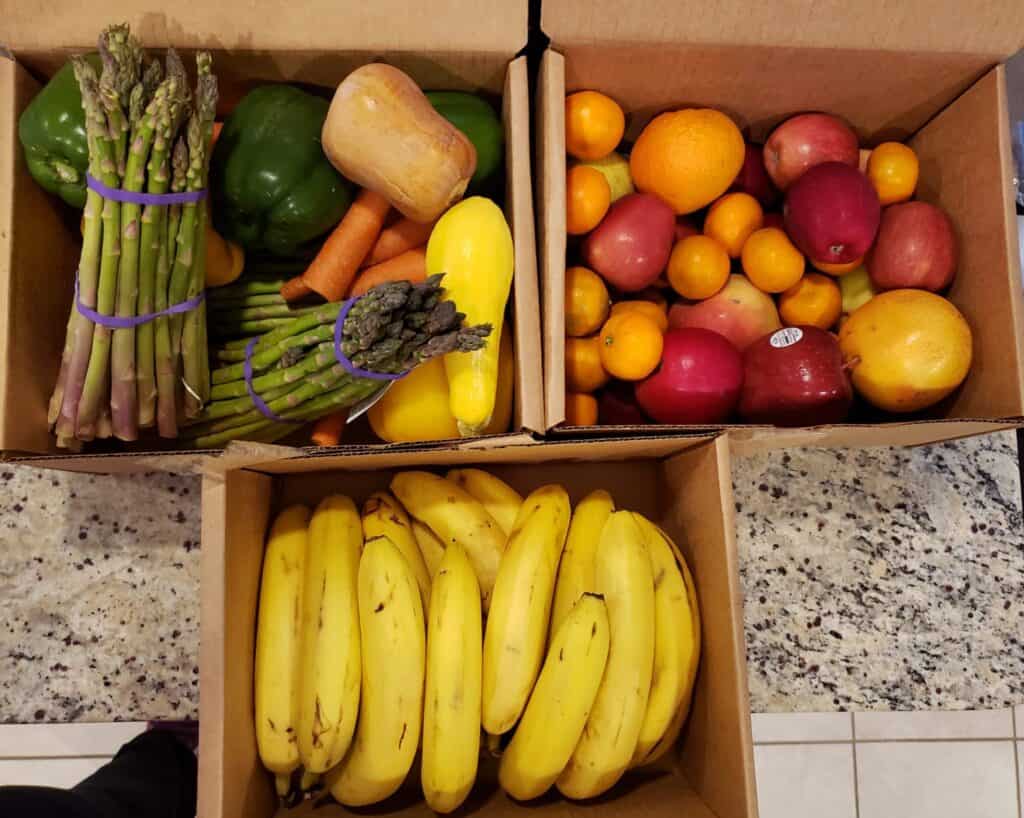
And yet another spread of fruits and vegetables (clearly, I have a pattern with what I buy, haha). I was pumped to get a bunch of avocados on this day! Peppers, onions, apples, and oranges are pretty common to get in the boxes. Everything below cost a total of $10 (two produce boxes).
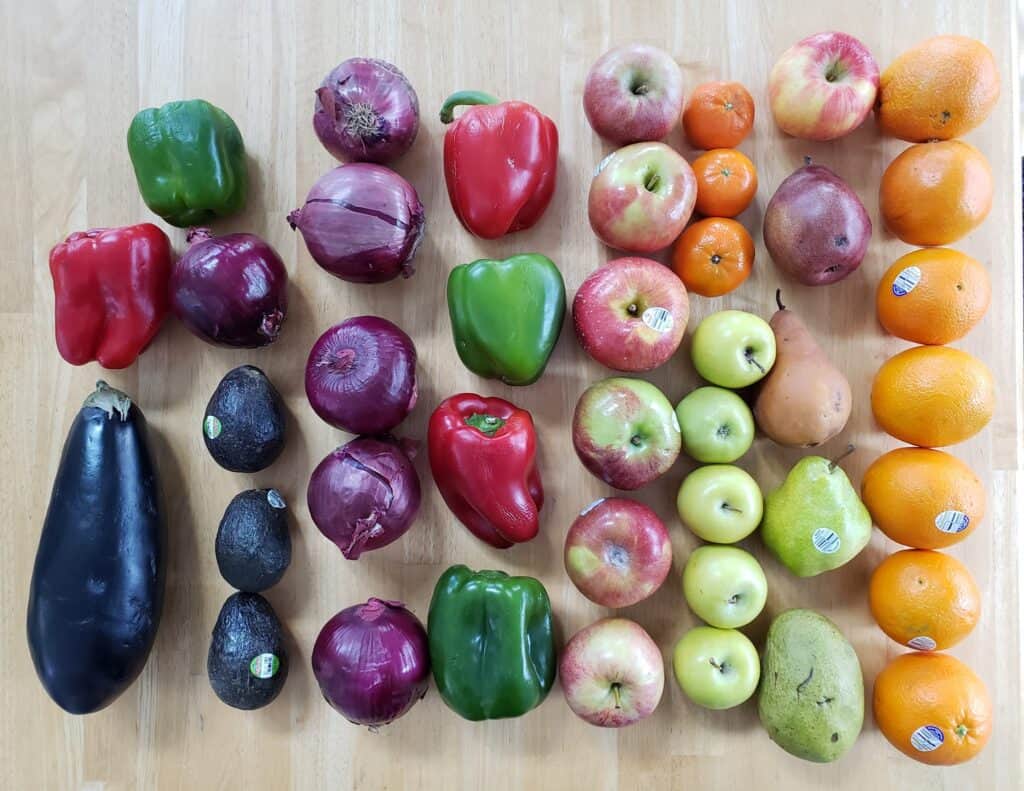
Here is one last example – a produce box, two containers of salad greens, and pork chops, which came to $12 total. We had quite a few salads on the menu that week!
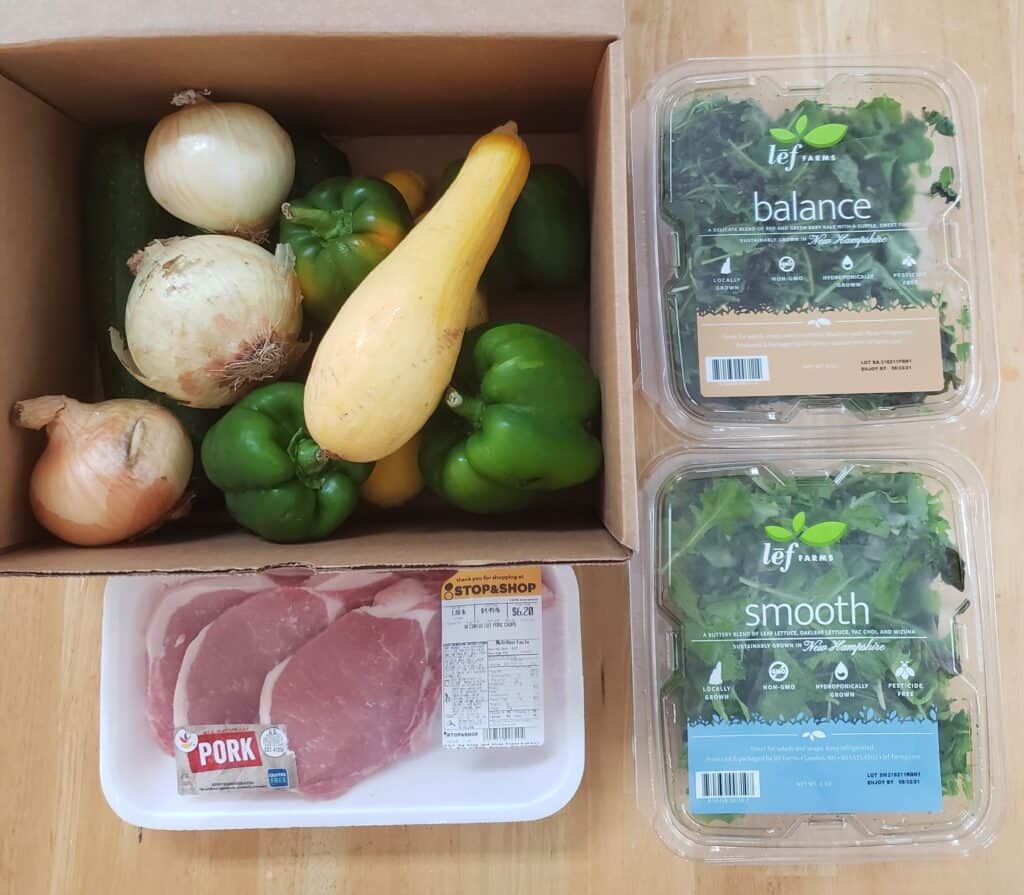
How much can you save?
It really depends on what you buy! As you can see, I find the produce boxes to be the biggest deal, often saving me up to 70% of what the food would cost to buy it individually.
For most items, though, the prices are typically marked 50% of the retail cost.
Unfortunately with inflation, that may not be as big of a savings as it used to be, as the standard retail cost has gone up. But it still makes a big difference in our grocery bill.
My best tip to ensure the biggest savings is to first shop on Flashfood, then plan your meals as much as possible around the discounted items you’re buying in the app. For example, in one of the photos above, I got burgers, sausage, and ravioli, along with the produce boxes. I planned meals like:
- Burgers with sweet potato fries and a caprese salad (using the burgers, sweet potatoes, and tomatoes from my order)
- Sausages with peppers and onions (using the sausage and peppers from my order)
- Ravioli with pasta sauce (using the ravioli from my order)
- Stuffed peppers (using the rest of the peppers from my order)
- Breakfast for dinner – banana oat pancakes, eggs, sliced fruit (using the bananas, apples, and oranges from my order)
Then I just need to shop for the couple of extra items – like buns, pasta sauce, ground beef, rice, eggs, and oats – to complete the meal ideas. (And I go to ALDI to get those items, which is right across from the Stop and Shop where I pick up my Flashfood order – as it tends to be cheapest in our area).
Essentially – Flashfood + meal planning = major savings!
Food safety and Flashfood
Many people are concerned about purchasing food that’s nearing it’s expiration date or that has slight imperfections. But this is one of the reasons so much good food goes to waste!
Here are a few key facts for you to know that will help you feel more comfortable buying foods close to “expiration” dates:
- Food expiration dates are only for product quality, not food safety. According to the USDA, “Manufacturers provide dating to help consumers and retailers decide when food is of best quality. Except for infant formula, dates are not an indicator of the product’s safety and are not required by Federal law.”
- “Best if Used By/Before” indicates when a product will retain best flavor/quality, “Use By” is the last date recommended for peak flavor/quality, and “Sell-By” is for the store’s inventory management. None of these are safety dates (unless the product is infant formula).
- The USDA specifically says “With an exception of infant formula, if the date passes during home storage, a product should still be safe and wholesome if handled properly until the time spoilage is evident. Spoiled foods will develop an off odor, flavor or texture due to naturally occurring spoilage bacteria.”
Hopefully this helps you feel more comfortable! Of course, there’s a few good tips to put into place:
- If buying meat that’s close to the sell-by date, plan to cook it or freeze it within a day.
- Give meat and fish the “smell test” to help determine if it’s still good. Anything that smells off should be tossed. Fish should not smell particularly “fishy”.
- Freeze baked goods like baguettes or biscotti until you’re ready to enjoy them; this will keep them fresh longer.
- If you buy yogurt and won’t be able to eat it all before it goes bad, you can freeze extra in an ice cube tray and use it to throw into smoothies.
- Produce with small bruises or imperfections are still perfectly fine to eat, just cut out that bruised spot. In fact, the USDA says that you can even cut mold spots off of firm produce (like cabbage, bell peppers, or carrots) and enjoy the rest of the item.
- If you buy extra produce (like in the $5 boxes), freeze some to use in later cooking or smoothies.
- Try to plan your meals around the items that will go bad quickest, using these earlier in the week.
- Note which stores you have the best and worst experiences with as far as food costs and quality, and shop accordingly. I’ve never had any issues with the stores near me – but I know I’ve seen occasional chatter in some of my budgeting groups where people have had a one-off issue with spoiled food or missing items. Of course, Flashfood will refund you for issues like this, but it does take a few days to get a response.
The Bottom Line
If you’ve made it this far in the post, chances are you’re at least a little interested in trying out Flashfood for yourself. I would absolutely recommend giving it a shot, whether you’re looking for ways to save money on groceries or simply want to help prevent excess food waste at the retail level.
Don’t forget to use my referral code CHRI2VVQP when you sign up so you’ll get $5 in rewards with your first purchase over $10. 🙂
Share: Have you ever used Flashfood? What was your experience like? Do you have any questions about the app?
